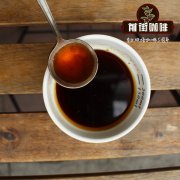What are the characteristics of Peruvian coffee? Peruvian coffee producing areas introduce how to drink Peruvian coffee?

Professional coffee knowledge exchange more coffee bean information please follow the coffee workshop (Wechat official account cafe_style)
Peruvian coffee comes from a variety of regions and climates, from the central and northern highlands to the jungle, ranging from 600m to 1800 m above sea level. In addition, Peru is the second-largest top producer of organic coffee, ranked fourth in terms of sustainable certification, and is particularly popular in the United States and Germany, where the United States accounts for nearly 1/4 of total coffee exports, according to the United States Department of Agriculture.
Peru remains the fifth and seventh largest exporter of Arabica coffee in the world. Most of Peru's coffee comes from small farmers limited by infrastructure. However, when given the opportunity on the international stage, the Peruvian local varieties grown in many of the country's cafes with ideal climatic conditions have proved dazzling.
All grades of Peruvian coffee are eligible for the "Caf é sdelper ú" brand, but the specialty coffee will be marked as "especially ialidadeshost nicas" (unique features). The new brand will appear on all collateral, including packaging and signage, within a month at the earliest. It will be used by all participants in the supply chain, including cooperatives, importers and bakers.
Peruvian coffee is on the list of coffee in the world and is comparable to the top coffee beans in traditional Central America. It is recognized as the most in the country in the world. Will have a strong aroma.
Peru is dominated by small farmers, each with less than two hectares of land and produces about 3000 pounds of coffee per hectare. Organic cultivation has a long history and is quite common in Peru. The main reason is that farmers here have opportunities or capital investment in chemical fertilizers, pesticides and herbicides. But in recent years, due to climate change, coffee leaf rust has spread in various countries, because of organic cultivation, but also caused a massive reduction in Peruvian coffee production. Peruvian coffee trees are planted in high altitude areas, mainly Arabica varieties. Under the slow mature growth, the density of beans here is higher, and the flavor changes a lot. Among them, the highest altitude, Peru's most important coffee producing area is: cha Mayou Chanchamayo, located in the central highland on the eastern side of the Andes. This was followed by Amazon Amazonas and San Martin San Mart í n, located in the northern highlands on the eastern side of the Andes.
Peru has good economic conditions and a stable political situation, thus ensuring the good quality of coffee. However, there are many local problems, in addition to guerrilla warfare and drug trafficking, the emergence of cholera along the coast in the mid-1990s led to a further economic depression, and what is more, the annual inflation rate reached 7000%.
In the mid-1970s, Peruvian coffee production was about 900000 bags a year, and then steadily increased to about 1.3 million bags a year. Although private exporters buy coffee in remote areas through middlemen, the main market is still monopolized by the government. Later, the private Peruvian Coffee exporters Association (Comera de Exportadoresde Cafe del Peru), which is committed to improving the quality of coffee, its primary task is to set standards and eliminate inferior products, so as to create an atmosphere of quality supremacy. This positive move heralds a bright future for the coffee industry. Since then, rising prices have encouraged farmers to actively grow coffee instead of ── cocoa, the region's traditional cash crop.
Peru's finest coffee is produced in Chanchmayo, Cuzco, Norte and Puno. Most Peruvian coffee is grown under natural conditions, but it is also difficult to confirm the cultivation of all coffee trees. Coffee grown under natural conditions costs 10% more than others. Judging from poverty, farmers may not have the money to buy chemical fertilizers and pesticides, but it is really difficult to confirm all the coffee.
The quality of Peruvian coffee is comparable to that of any kind of coffee in Central or South America. The high quality coffee produced by Peru is shipped to Germany for blending and then to Japan and the United States, which also illustrates its high standard of quality.
Qianjie recommends Peruvian coffee brewing parameters:
V60According to one minute and fifty seconds, 15 ℃ / time
Important Notice :
前街咖啡 FrontStreet Coffee has moved to new addredd:
FrontStreet Coffee Address: 315,Donghua East Road,GuangZhou
Tel:020 38364473
- Prev

How about Peruvian coffee? What are the producing areas of Peruvian coffee? How do you drink Peruvian coffee?
Professional coffee knowledge exchange more coffee bean information please pay attention to the coffee workshop (Wechat official account cafe_style) Peruvian coffee has always been used as one of the stable mellow mixed beans of comprehensive coffee, which is relatively low-key in the coffee industry. But as more and more people like the mellow taste of Peruvian coffee, Peruvian coffee has sprung up rapidly in the international market in recent years, winning many international coffee awards.
- Next

What are the characteristics of Peruvian coffee in Peruvian coffee bean producing area? How should I drink Peruvian coffee?
For more information on coffee beans, follow the Coffee Workshop (official Wechat account cafe_style) Peru has been growing coffee in the region for a long time-around the mid-1700s. We are not sure how it reached much of Central America faster, which is actually closer to plant sources in the Caribbean. This is a mystery. Of course
Related
- Detailed explanation of Jadeite planting Land in Panamanian Jadeite Manor introduction to the grading system of Jadeite competitive bidding, Red bid, Green bid and Rose Summer
- Story of Coffee planting in Brenka region of Costa Rica Stonehenge Manor anaerobic heavy honey treatment of flavor mouth
- What's on the barrel of Blue Mountain Coffee beans?
- Can American coffee also pull flowers? How to use hot American style to pull out a good-looking pattern?
- Can you make a cold extract with coffee beans? What is the right proportion for cold-extracted coffee formula?
- Indonesian PWN Gold Mandrine Coffee Origin Features Flavor How to Chong? Mandolin coffee is American.
- A brief introduction to the flavor characteristics of Brazilian yellow bourbon coffee beans
- What is the effect of different water quality on the flavor of cold-extracted coffee? What kind of water is best for brewing coffee?
- Why do you think of Rose Summer whenever you mention Panamanian coffee?
- Introduction to the characteristics of authentic blue mountain coffee bean producing areas? What is the CIB Coffee Authority in Jamaica?

